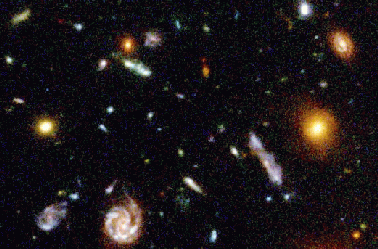Visualizations:
Formation of a group of galaxies
From quantum foam to galaxies:
formation of the large-scale structure in the Universe

|
|
|
One of the greatest challenges of modern astrophysics is understanding how various structures, such as galaxies and galaxy clusters, form within the framework of the Big Bang cosmology.
The current theory of structure formation, the extension of the Big Bang model called the Cold Dark Matter (CDM) scenario, predicts that massive galaxies and galaxy clusters were built from smaller galaxies that collided and merged, inducing bursts of star formation and resulting in the different types of structures observed today.
The sequence of events is thought to be seeded by quantum fluctuations in the very early Universe. These tiniest fluctuations were stretched by many orders of magnitude during a brief period of extremely rapid exponential expansion of the Universe called inflation. The growth of structures is thought to be governed by mysterious "dark matter" which constitutes about 85% of all matter in the Universe. The entire history of the cosmos in all its complexity is governed by a handful of cosmological parameters, such as the density of ordinary matter (baryons), the density of ``dark matter'', thought to consist of weakly interactive particles, and ``dark energy''.
The theory is both elegant and simple as it connects the processes operating on the smallest imaginable scales during the first 10-33 seconds in the evolution of the Universe to the formation of the largest structures observed today.

 The Center for Cosmological Physics is a Physics Frontier Center of the National Science Foundation
The Center for Cosmological Physics is a Physics Frontier Center of the National Science Foundation 